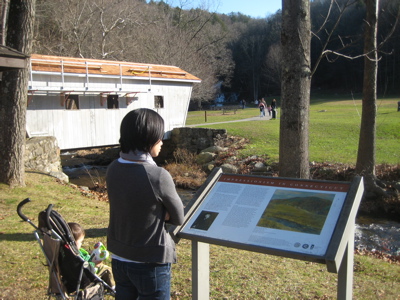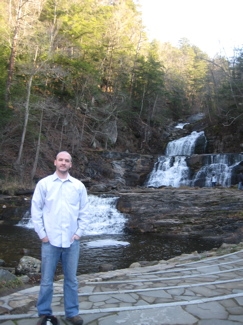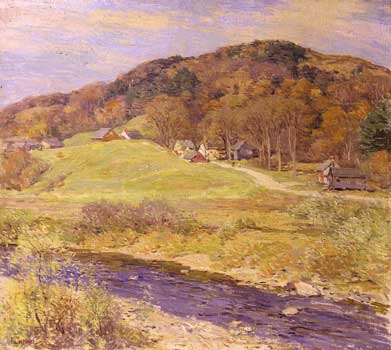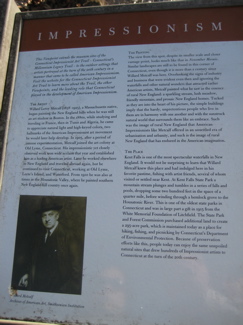Kent Falls Viewpoint
CT Art Trail Viewpoint
Kent Falls State Park, Kent, November 2009
Here’s the weird thing about this Connecticut Art Viewpoint Trail, side project of the Connecticut Art Trail: The chosen sites, while beautiful, don’t all apparently directly translate to actual impressionist paintings from Connecticut masters of the past. Perhaps borrowing some of the impressionist ethos, the chosen viewpoints are merely “representative” of what the painters profiled along the way “might” have seen to influence their art. Hey daddy-o, I can dig it.

And you can dig some of what the sign says, painstakingly transcribed (with small edits) by me, right here, for you:
The painted chosen to be profiled at this site is some guy named Willard Leroy Metcalf (1858-1925), a Massachusetts native. He began painting the New England hills when he was still an art student in Boston. In the 1880’s, while studying and traveling in France, then in Tunis and Algeria, he came to appreciate natural light and high-keyed colors, two hallmarks of the American Impressionist art movement he would later help develop. In 1905, after a period of intense experimentation, Metcalf joined the art colony at Old Lyme. His impressionistic yet closely observed work won wide acclaim that year and established him as a leading American artist. Later, he worked elsewhere in New England and traveled abroad again, but he continued to visit Connecticut, working around the state, including the Housatonic Valley, where he painted southern New England hill country once again.

The Painting:
This info (and painting) comes from the New Britain Museum of American Art site, which has cooler information than the sign.
Metcalf’s vision of “summerland”-a world of perpetual sunshine and perfect repose-was not just another pretty concept; instead, it epitomized his spiritualist concept of the afterlife. Despite his own troubled adulthood (which included two divorces and a history of alcoholic binges), Metcalf held to this ideal, which guided his career as America’s foremost Impressionist landscape painter.

November Mosaic embodies this idealism. Dating to the prime of Metcalf’s career, when he produced some of his most beautiful autumn paintings, the canvas was executed in fall 1922, when he was staying in the little stone village in Chester, Vermont. The nearby Little Williams River often plays an important role in his compositions; here it is seen against the backdrop of the New England hills, covered in early autumn tones and dotted with houses. Metcalf selected a slow, deliberate painting speed which emphasized patchy brushstrokes of variegated colors, hence the apt reference in the title to a “mosaic.” Using classic compositional devices, such as crossing diagonals and crisp contrasts of texture and value, Metcalf quite literally and painstakingly constructed a scene of consummate serenity and solitude, a mood that one of his reviewers described at the time as “lyric in a positive, masculine style.”
Kent Falls is one of the most spectacular waterfalls in New England. It would not be surprising to learn that Willard Metcalf knew of this place and had indulged here in his favorite pastime, fishing with artist friends, several of whom visited or settled near Kent.

The sign goes on to discuss the falls themselves, but I’ve also done that myself.
Connecticut Art Viewpoints Trail
Connecticut Art Trail

Leave a Reply